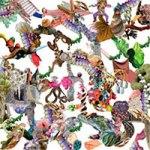
Kemialliset Ystävät Ullakkopalo
(Fonal Records)
Remember that scene in the first Toy Story movie when Woody and Buzz first encounter Sid’s twisted toy collection? Mounted to the front of a skateboard, an action figure separated from his lower half rolls himself across the floor. A pair of human legs topped by a small construction crane struts eerily forward. And, most disturbing of all, a baby doll’s head emerges from the shadows, actually the crown of an Erecter set creation resembling a large mechanical spider. These images were freaky (for both Woody and the audience) because they violated our preconceived notions of form, or what other things should look like, how they should be structured, etc. People often create art by merging elements that previously existed independently of one another. However, as demonstrated by Toy Story’s depiction of toys with both human and mechanical features, combining very disparate concepts to create new work can have very unsettling effects.
The music of Kemialliset Ystävät (Finnish for “Chemical Friends) is similar in the sense that their work is also the product of such drastic compilings and rearrangements of sounds. Kemialliset Ystävät’s general approach to making music entails layering both acoustic and electronic sounds on top of one another, only some of which are identifiable. Extraterrestrial synths and other sound effects blurp and hum at unpredictable intervals, while repetitive tribal drums, other eclectic percussion, and scraped string instruments prevent tracks from turning to sheer rhythmic mush. Occasionally, a fuzzed out electric guitar surfaces to contribute some circular riff. The endeavor results in a wash of sounds that wouldn’t be out of place as the music accompanying a modern art exhibit, or a DVD playback menu’s looped backing track.
To give you an idea of the album’s overall texture and production, Julian Lynch’s recent Mare represents a fairly decent landmark: Both artists weave otherworldly electronics amidst analog sounds, in addition to recording their live instruments “dry”, without the use of heavy reverb or other studio effects. The similarities stop here though, as Mare was far more composition-oriented than Ullakkopalo, which is instead comprised of littered, hyperactive soundscapes than actual songs.
In summary, as strange as Kemialliset Ystävät’s work is, primary architect Jan Anderzén should be commended for creating something that sounds so inhuman. Likewise, there’s a playful nature to the album that suggests Anderzén doesn’t take his work too seriously. Yes, the album sounds as though it were recorded by aliens (though the mask slips a bit on tracks featuring more conventional melodic motifs such as Kajastumuseo and Lyön Häntäni Vetoa), but whatever intelligent life Anderzén has imagined, they ultimately sound friendly. Props for being weird without pretense, maybe something to put on when even old Animal Collective records have begun sounding too normal.
5 September, 2010 - 20:43 — Anthony Porreco